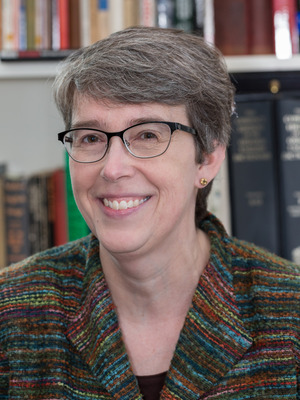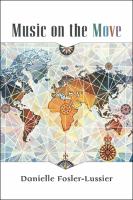Author success story
Context about the author:
Danielle Fosler-Lussier is Professor of Music at the Ohio State University. Her interests include global mobility, the political and social dimensions of music, women’s roles in musical life, and how we teach and learn music history. Her 2015 book Music in America’s Cold War Diplomacy is accompanied by an online database of U.S. cultural presentations from the 1950s to the 1980s. From 2020 to 2022, she is serving as Vice President of the American Musicological Society.
Please provide some background information on the research project, book origin, adjacent research, and/or network enabling the book
This book originated in a course of the same name, which was developed in the mid-2000s to serve International Studies majors and Music minors at Ohio State University. The course aimed both to introduce students to many different styles of music and to help them learn to think about the ways in which music has moved through migration and mediation. Over several iterations of the course, I found that a great deal of reading available on these topics was difficult for beginners, so I began writing my own accessible readings. These readings eventually began to look like a book, and Mary Francis (then of the University of Michigan Press, now Director of the University of Pennsylvania Press) urged me to consider publishing it.
I was grateful for a year’s research leave in 2017-18 that allowed me to update and revise the text. Preparing the multimedia components of the book, including video, audio, and digital maps, occupied a great deal of time between 2018 and the book’s publication in 2020.
What was/were your motivation(s) for wanting to publish this book?
I wanted a book for students and the general public that covered music neither chronologically nor geographically, but by explaining key social concepts related to the sharing of music, like appropriation and copyright, as well as the ways in which music moves across social boundaries. These concepts seem to me essential for listeners today: they live in a world in which music is constantly mixed and remixed. I also wanted to create an introductory text that was broader and more inclusive than most books of its kind, with coverage of music made by women and/or musicians of color throughout.
Please give some information on the funding behind the research / book / network
Music on the Move was supported by a grant from The Open Monograph Initiative (TOME) and the Ohio State University Libraries. This grant of $15,000, awarded through an on-campus selection process, went directly to the University of Michigan Press to defray the cost of making the book open access. The book appeared with its embedded media in the Fulcrum platform and on the Ohio State University Knowledge Bank and other repositories as a PDF.
Was the book made available on your own website, or the website of any other editors or contributors, or your institution? If so, please state which.
The Ohio State University Knowledge Bank hosts a copy of the book at my institution. This was a condition of the TOME grant. I also shared it on my own website.
Open access success story:
What makes this book successful?
Colleagues have told me that they like the book’s conciseness and its clear language about challenging ideas. That the book was freely available online in 2020, when libraries were shut down during the COVID-19 pandemic, likely speeded its adoption for use in university-level courses: we could not have predicted that!
Why did you choose to publish this book open access?
I wanted this to be an accessible book: both one that readers could easily understand and one they could afford. Because the book had originally existed digitally, within a course management system, it included links to a great deal of media: it was difficult to imagine this book existing separately from the music it described. One reason I chose to work with Michigan was that their digital platform, Fulcrum, had the capacity to host a book with built-in media. Encouraging people to consider the music and the ideas about the music together is a principle central to my teaching.
Do you think that open access publication helped the book and if so, why?
This book circulated much more widely than my previous books, which were not open access publications. Open access has allowed people to use the book however they like: they can just use the chapter that interests them without having to buy the book, and they may arrive at it through casual Googling, without the obstacle of having to stop and acquire it before reading it. I believe that the immediacy of access is an important factor.
Did your OA book show immediate success upon publication, or did the success unfold more slowly over time?
The pattern of use of the book follows the rhythms of the academic year, with the highest use in April and October. It took a year to get established, and the highest use to date was in October 2021.
If early signs of success started to show, did you try to reinforce this in an unusual or creative way?
The book was published just as the COVID-19 pandemic shut down conferences and in-person presentations. The University of Michigan Press held a series of online webinars promoting individual books and the July 9th, 2020, webinar for Music on the Move helped showcase the different elements of the book (including interactive maps, audio, and video clips) effectively.
Did open access help to reach unreachable / unknown / unexpected / new audiences? If yes, how do you know this?
The book has been adopted by other instructors, and some of the resources have also been individually integrated into open educational programs around the world. We see the use of these resources through the Press’s Google Analytics usage log (in the list of titles with the most page views, many of the individual songs show up as highly used). The comments of respondents to the Press’s reader questionnaire, which pops up whenever an OA book is used, are predominantly from students and instructors.
Did open access make new connections / follow-up possible?
It has been helpful to get the feedback of instructors who use the book in different kinds of institutions via the Open Textbook Network. There are detailed reviews from Eastern Mennonite University, Berkshire Community College, and the Metropolitan University of Denver. These are different kinds of institutions from The Ohio State University and so it is helpful to see how the book works pedagogically in different contexts. The Ohio State University Libraries have also used the book to promote OA at the University, as shown in this video: https://youtu.be/n2lvkjiAfmw
Is there any long tail (awareness, citations, downloads) of this book that you consider would (most likely) not have happened with print sales only or toll-access?
The different theoretical perspective the book brings is innovative in itself, but the open access availability and digital affordances that Fulcrum made possible probably helped with the book’s recognition by the American Musicological Society’s 2021 Teaching Award for an “exceptional pedagogical resource for musicology”. It’s a bit early to see a long tail, but the patterns of seasonal usage corresponding to when classes are taught make me hopeful that this book has been adopted.
How do you think academia can benefit from your book being OA?
For students, a free course book is a significant saving (music textbooks with CDs or online media may cost about $300). In a time when many teachers are revamping curricula to be more inclusive, I hope that this book provides an interesting model for doing that work. Because Music on the Move is not limited to one genre of music, but organized by concepts, it offers a way to structure a course that invites people to bring in their own related examples: it does not reflect a closed canon of valued works, but introduces ideas that readers can easily apply to music they care about, whether that music is covered in the book or not.
How do you think society at large can benefit from your book being OA?
To my mind, the ideas covered in this book are essential equipment for understanding and participating in our present-day world. If a person knows how colonialism has shaped cultural life, they are more likely to recognize the social and musical traces of colonialism they see and hear around them. If a person understands the musical effects of the diasporic movement of peoples, they are more likely to grasp why someone might be sensitive about the appropriation or imitation of their music. An understanding of copyright is essential for the music consumer awash in a sea of online media. These ideas should be widely available, not limited to a college classroom: I am delighted to see them in circulation, and I hope many people will find them illuminating.

This article is made available under a Creative Commons Attribution 4.0 International License.


